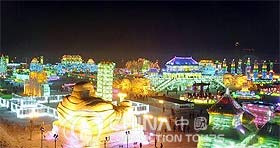 Harbin, capital of Heilongjiang Province, is located in the middle reaches of the Songhua River in the south of the province. It is the largest and most populous of China's provincial capitals. Besides being the center of politics, economics, science and technology, culture and transportation in northern northeast China, Harbin has a comprehensive industrial base, which includes, the manufacturing of electronics and machinery, textiles, automobiles, and chemicals The output value of its pharmaceutical industry ranks first in China. The main agricultural products from the area are wheat, soybeans, sugar beets, flax, tobacco, and poultry. Known as "Ice City," Harbin is famous for its winter scenery and bitterly cold temperatures. The annual Ice Lantern Festival, held from the 5th of January to the end of February, has attracted tens of thousands tourists from home and abroad.
Harbin, capital of Heilongjiang Province, is located in the middle reaches of the Songhua River in the south of the province. It is the largest and most populous of China's provincial capitals. Besides being the center of politics, economics, science and technology, culture and transportation in northern northeast China, Harbin has a comprehensive industrial base, which includes, the manufacturing of electronics and machinery, textiles, automobiles, and chemicals The output value of its pharmaceutical industry ranks first in China. The main agricultural products from the area are wheat, soybeans, sugar beets, flax, tobacco, and poultry. Known as "Ice City," Harbin is famous for its winter scenery and bitterly cold temperatures. The annual Ice Lantern Festival, held from the 5th of January to the end of February, has attracted tens of thousands tourists from home and abroad.
Geographic Features
Located in the eastern Songnen plain, it's a rolling land with low hills, and shallow valleys, crossed by the Songhua River. Harbin receives an average annual precipitation of 530 mm and a frost-free period of only 140 days. The annual average temperature in the city is 4.3C (36F), the highest monthly average temperature is 23C (72F) and the lowest is -15.8C (4F). Winter is cold and long, usually lasting seven months from October to April.
People
Harbin has a population of 9.48 million. Over 40 nationalities live in the area, most are Han nationality. Ethnic minorities include Manchurians, Koreans, Russians and Mongolians. The main religion here is Buddhism and Taoism.
History
 Archaeological records show that prehistoric humans lived in the area around Harbin as long ago as 22,000 years. The city first came into being with the settlement, in 1097, of the Nuzhen nationality, which founded the Jin Kingdom (1115-1234AD) and DaTsing (Qing) Empire (1644-1911AD) successively. The place was a natural fishing area, situated on the Songhua River. By the Yuan Dynasty (1271-1368AD) the area was named Harbin, meaning, "Where the fishing nets are dried."
Archaeological records show that prehistoric humans lived in the area around Harbin as long ago as 22,000 years. The city first came into being with the settlement, in 1097, of the Nuzhen nationality, which founded the Jin Kingdom (1115-1234AD) and DaTsing (Qing) Empire (1644-1911AD) successively. The place was a natural fishing area, situated on the Songhua River. By the Yuan Dynasty (1271-1368AD) the area was named Harbin, meaning, "Where the fishing nets are dried."
In 1896, the Russian government seized the area and extended the Siberian railway into northeastern China. They chose Harbin as a railhead. By 1898, the city had become a Russian concession. By 1903, when the railway was completed, a modern city was taking shape. Following its defeat in the Russian-Japanese War (1904-5), Russia's influence declined, and 160,000 nationals from 33 countries including the United States, Germany, and France moved to Harbin. Sixteen countries established consulates and set up several thousand industrial, commercial and banking companies. Harbin became an international metropolis. The Japanese took control of the city in 1932 as a part of the Japanese puppet kingdom of Manchukuo. The Soviets retook the city in 1945, remaining for almost ten years.

